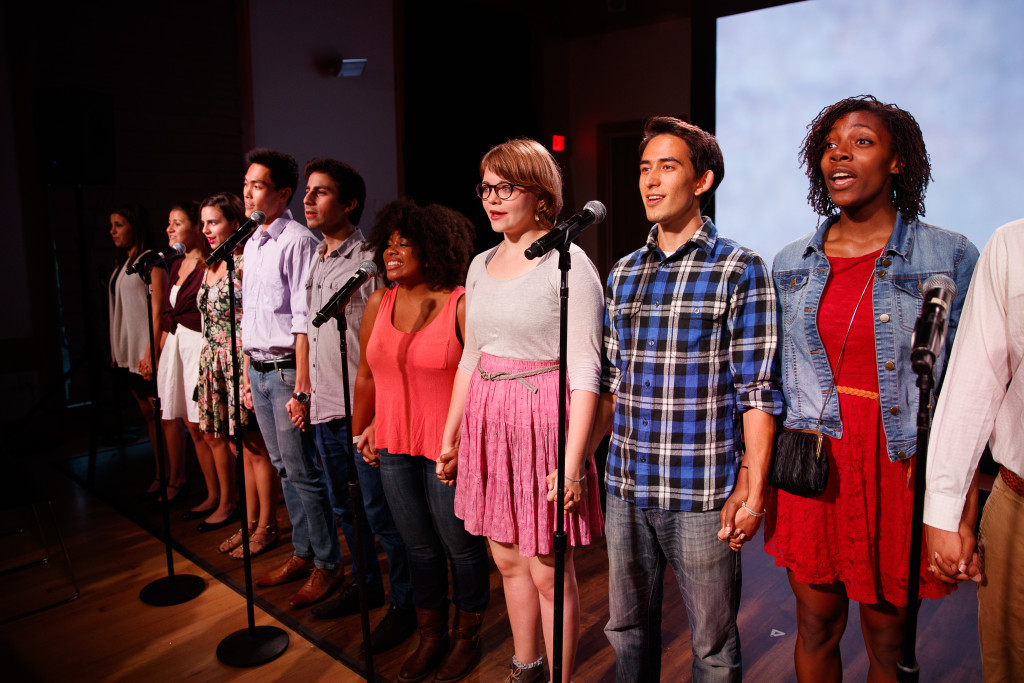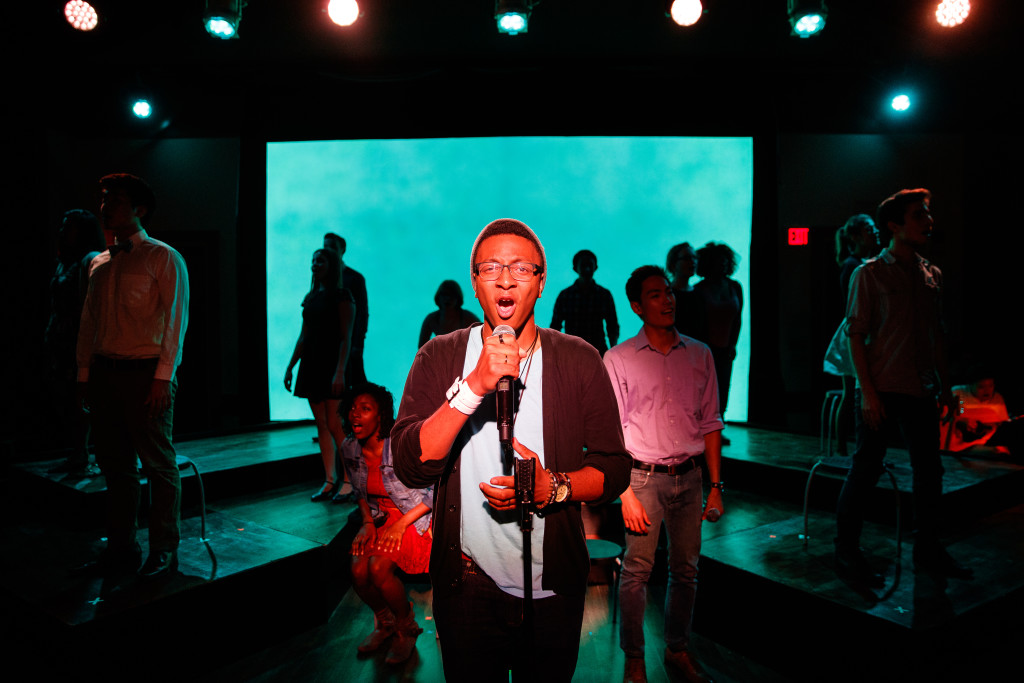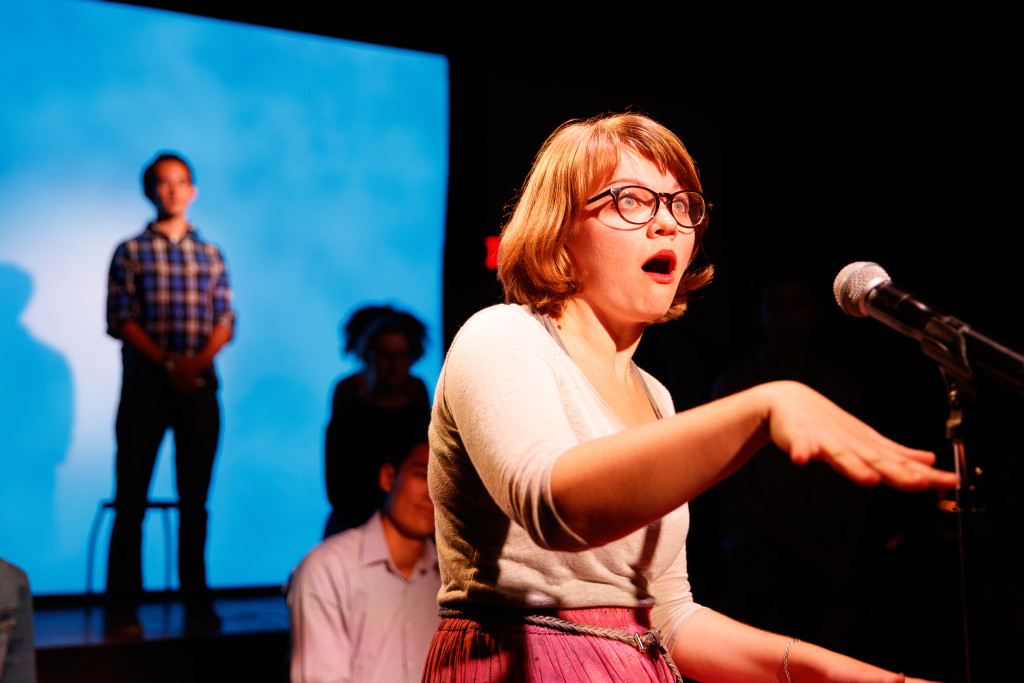
Before heading to see Theory of Relativity, I decided to take advantage of Spring Faire and hit some new dining halls. Though the air was cold and “Ricker” sounds like that bone thing, I made the trek from East to West campus, and was surprised to recognize so many passersby along the way. I biked past my brother’s freshman roommate. I ran into a kid from my dorm in line for the pork buns. I saw that girl who knows my friend eating dinner with that dude who always jogs around Lake Lag the same time I do. I began my evening reminded of familiar faces, the odd and unexpected connections we share, and a myriad of unique stories. Little did I know this was only the beginning.
The new musical Theory of Relativity, making its West Coast debut at the Elliott Program Center this weekend through Stanford’s very own Ram’s Head Theatrical Society, explores universal truths and personal experience, emphasizes commonality and individuality, and most of all (as printed on the glossy and graphically enticing playbills), is a “musical about relationships.”
The show is relatable, yet unconventional. Written and composed by Drama Desk Award Nominees Brian Hill and Neil Bartram, the show premiered in Toronto and then London 2014. Inspired by real personal interviews with students from Sheridan College, the show takes a look at the interconnectedness of our lives and the ubiquity of human experiences in a way that is particularly geared towards college students.
In addition, the unique structure of Theory makes it distinct from most musicals. At the top of the show, seven microphones stand in a line in front of a raised stage below a projected backdrop of rectangular color. Once the 13 cast members walk onto the stage, they will stay there for the entirety of the show. Instead of following one protagonist surrounded by peripheral characters, we are given an obliviously intertwined group of people, each of whom are in the spotlight at some point in the show. Made up of a series of monologues, short scenes, and songs, the performance ping pongs between group and individual, not bound by one linear narrative but still clear and, importantly, connected.
Ram’s Head’s rendition of this unique show is, above all, polished. Thanks to attention to detail and a strong cast dynamic, the production is clean and professional, and allows the story to be the center of attention. With smooth transitions and a coherent aesthetic, the technical aspects of the performance are solid and create a distinct ambience. Production elements like the visible student band and creative lighting design adds to the professional effect, and the intimate theater space pulls in the audience like gravity (*winky face*) to create another level of group energy as viewers experience the show together.

The cast itself mirrors this technical cohesion and professionalism, sparing the audience the discomfort that can accompany such new material. Though cohesively clad in semi-formal jewel tones (even Producer Sam Weyen ’18 and Director Alexander Ronneburg ’17 with dressed for the occasion on opening night), the actors share more than a sartorial bond. The team dynamic of this production is notable, in the energy on stage, the playful playbill, even SnapChat stories (check out the Theory of Relativity filter next time you’re near White Plaza or EPC). The performers on stage are competent, consisting of essentially half the cast of Ram’s Head’s Rent and a handful of other familiar faces from various Stanford stages, including comedy troupes and a capella groups alike. The actors skillfully commit to their roles and gracefully handle the potentially daunting task of being visible on stage for the entirety of the performance. They blend into the background when necessary and otherwise step wholeheartedly into the spotlight.
Some notable songs include two quirky solos about putting love before cat problems, sung by Peter Kurzner ’17 and Holly Dayton ’17 respectively, the recurring meditations of a nervous physics major preparing for a date (Bright Zhou ‘16), a ragtime-esque duet between best-frenemies-forever Clarissa Carter ‘19 and Samantha Williams ’16, and an all-cast coffee shop daydream called “Nothing Without You.” Scenes also including the reoccurring meditations of germophobe without “a technique for cake” (Justine DeSilva ‘16) and a slow-motion collision fraught with unrequited love.
Some troubling moments in the show arise because of the nature of the musical. Being an inherently light genre, more difficult subjects facing young adults run the risk of appearing melodramatic or superficial when put into song, and the suddenly unhappy pieces of the show can feel particularly dark. This is most notable in the song Me & Ricky, a sultry number sung by the character, Caroline (Cayla Pettinato ’17). This song is actually quite entertaining, but once it reaches the heartbreaking conclusion and Caroline reveals her presumably irreversible emotional turmoil, the backup singers may start to feel a bit inappropriate. The juxtaposition of the light music and the heavy subject matter forces the audience to consider the real interviewee; it doesn’t let us escape from the reality of the situation, and leaves us to ponder her actual experience. A similar concern faces the subject of parental death in “Promise Me This” and of familial and community pressures to succeed in “Great Expectations,” as the playful tone of a musical can only capture so much rawness of emotion. Some may thus view such songs as potentially disrespectful or oversimplified presentations of their topics, but perhaps we might look at them another way. Though unsettling, these instances challenge us to think about the “drama” of out own lives. How important do retrospectively significant life events really feel in the moment that we are experiencing them? We don’t have the luxury of musical cues to foreshadow and prepare us for the profound moments of our own lives, so why should we get them in a performance? As Amy (Tess McCarthy ’19) remarks in the show’s closing monologue, “the speed of life. Whether you’re running from it or toward it, it hits you at the same time.”

The Theory of Relativity is about the interconnectedness of our personal journeys, and with its strong cohesion and fluid group energy, the Ram’s Head production does this mission justice. Whether they include commonalities, like returning home from college to find things changed or carrying the weight of parental expectations, or if they include more unique experiences, like losing a parent or sharing a special blind date, our live paths are interwoven, interconnected, and interdependent. Theory shows us that the individual is a product of their relationships, and can have profound effects on those with whom they come in contact. This Ram’s Head production reminds us of our shared energy as Stanford students, as young adults, and as people.
Photos courtesy of Frank Chen.
